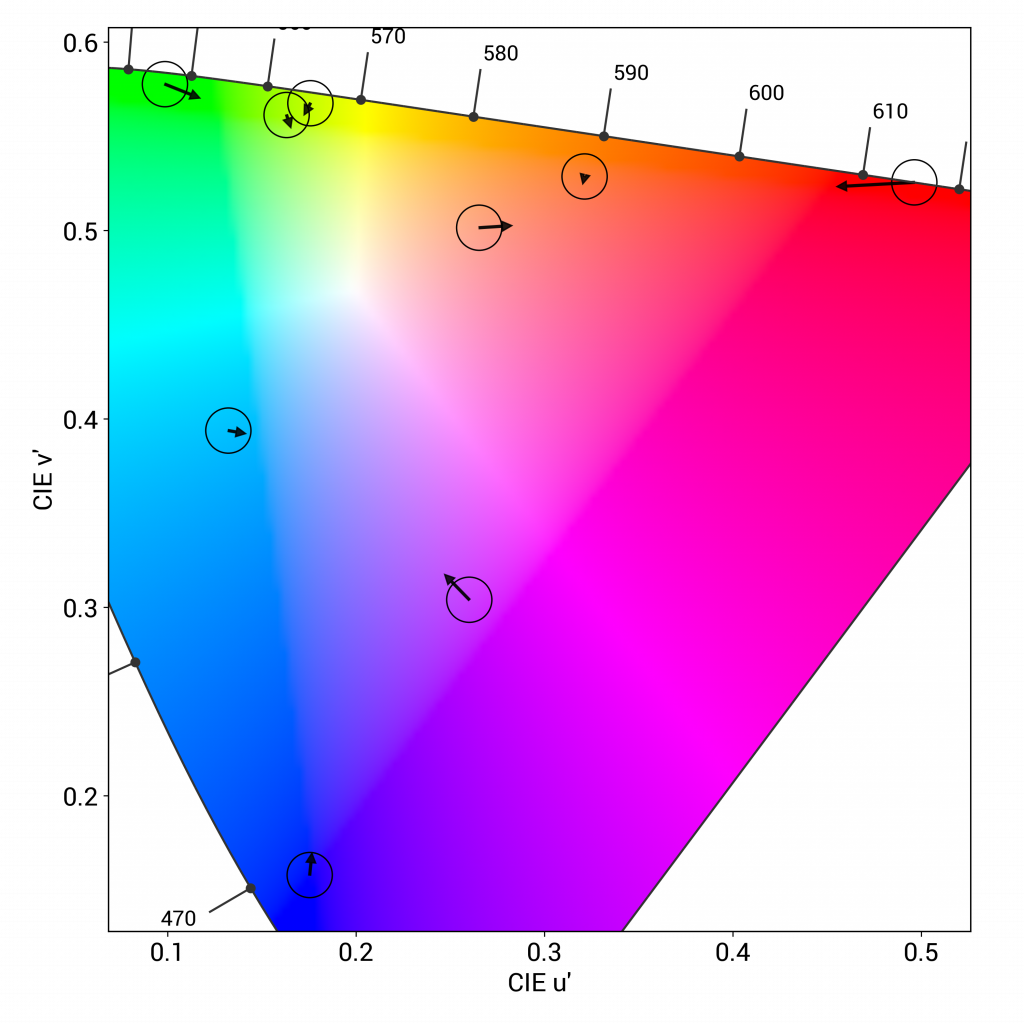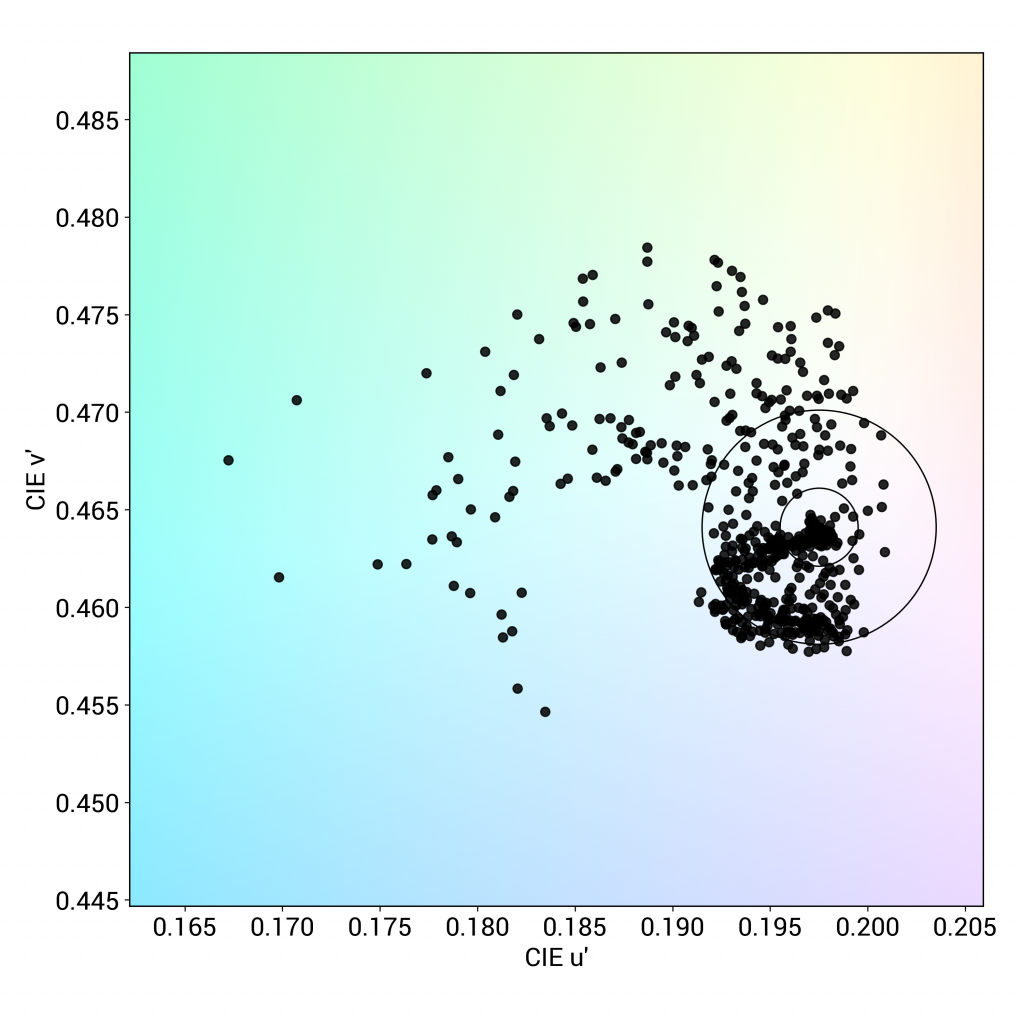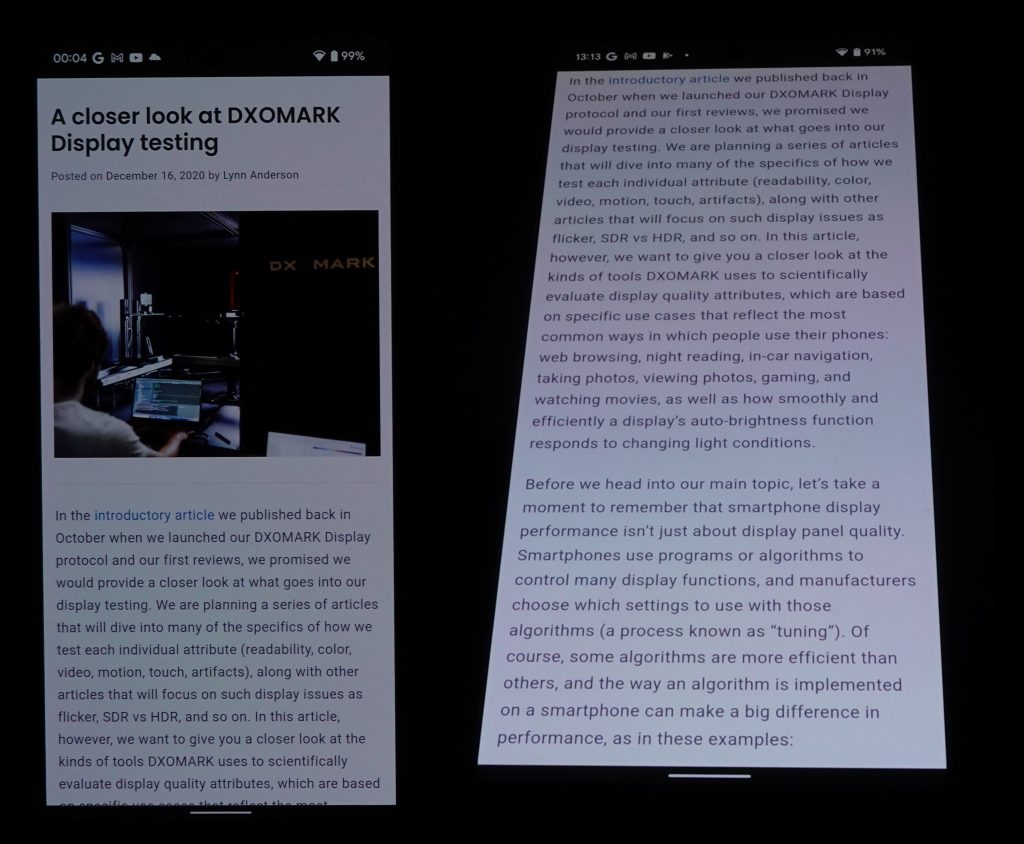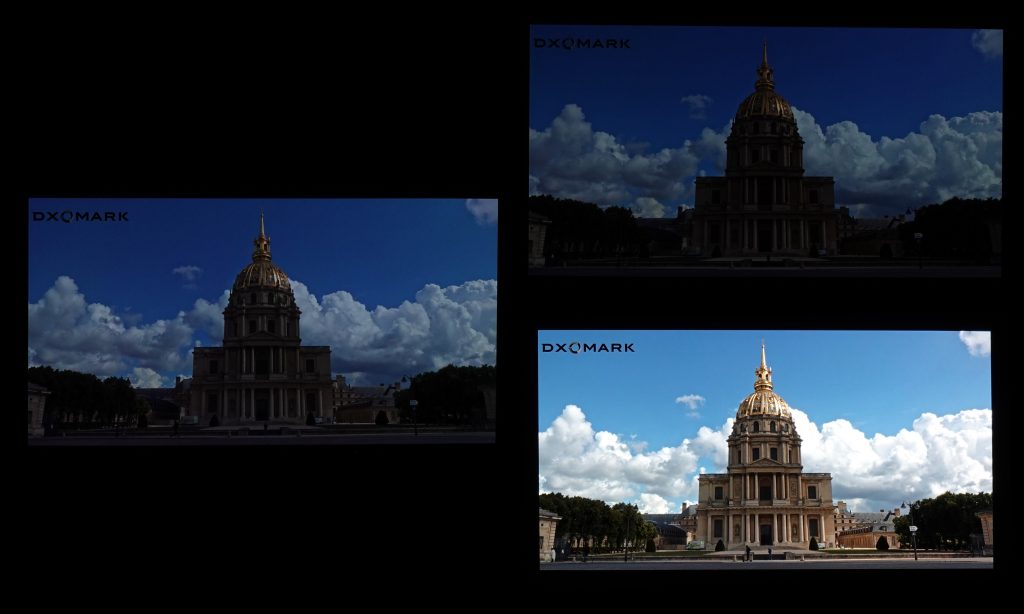The Google Pixel 6 appeared on the market at the end of October 2021. We present here some of its key results in our comprehensive Display protocol tests.
Key display specifications:
- 6.4-inch OLED screen
- Resolution: 1080 x 2400 (411 ppi)
- Aspect ratio: 20:9
- Refresh rate: 90 Hz
About DXOMARK Display tests: For scoring and analysis in our smartphone and other display reviews, DXOMARK engineers perform a variety of objective and perceptual tests under controlled lab and real-life conditions. This article highlights the most important results of our testing. Note that we evaluate display attributes using only the device’s built-in display hardware and its still image (gallery) and video apps at their default settings. (For in-depth information about how we evaluate smartphone and other displays, check out our articles, “How DXOMARK tests display quality” and “A closer look at DXOMARK Display testing.”)
Test summary
Scoring
Sub-scores and attributes included in the calculations of the global score.
 Google Pixel 6
Google Pixel 6

125
display
129
Samsung Galaxy S24 Ultra
Best: Samsung Galaxy S24 Ultra (164)
135
Google Pixel 10
Best: Google Pixel 10 (167)
111
Samsung Galaxy S25 Ultra
Best: Samsung Galaxy S25 Ultra (167)
134
Google Pixel 7 Pro
Best: Google Pixel 7 Pro (164)
Please be aware that beyond this point, we have not modified the initial test results. While data and products remain fully comparable, you might encounter mentions and references to the previous scores.
Position in Global Ranking

135
th
1. Google Pixel 10 Pro XL
161
2. Samsung Galaxy S25 Ultra
160
4. Samsung Galaxy S25 Edge
158
10. Google Pixel 10 Pro Fold
156
10. Samsung Galaxy S25 FE
156
13. Samsung Galaxy Z Fold7
155
13. Samsung Galaxy Z Flip7
155
13. Samsung Galaxy S24 Ultra
155
17. Samsung Galaxy Z Fold6
154
17. Samsung Galaxy S24+ (Exynos)
154
17. Samsung Galaxy S24 (Exynos)
154
24. Google Pixel 9 Pro Fold
152
26. Apple iPhone 17 Pro Max
151
26. Apple iPhone 15 Pro Max
151
34. Apple iPhone 16 Pro Max
150
34. Samsung Galaxy Z Flip7 FE
150
34. Samsung Galaxy Z Flip6
150
44. Samsung Galaxy S23 Ultra
148
50. Samsung Galaxy A55 5G
147
53. Apple iPhone 14 Pro Max
146
55. Samsung Galaxy S24 FE
145
59. Samsung Galaxy Z Flip5
144
62. Asus Zenfone 11 Ultra
143
62. Samsung Galaxy A35 5G
143
67. Apple iPhone 13 Pro Max
142
67. Samsung Galaxy Z Fold5
142
73. Samsung Galaxy S23 FE
140
78. Xiaomi Redmi Note 14 Pro+ 5G
139
79. Honor Magic4 Ultimate
138
90. Samsung Galaxy S22 Ultra (Snapdragon)
135
90. Xiaomi Redmi Note 13 Pro Plus 5G
135
95. Samsung Galaxy S22+ (Exynos)
134
98. Samsung Galaxy Z Flip4
133
98. Samsung Galaxy S22 Ultra (Exynos)
133
98. Samsung Galaxy S22 (Snapdragon)
133
98. Vivo X80 Pro (MediaTek)
133
103. Samsung Galaxy S22 (Exynos)
132
108. Samsung Galaxy S21 Ultra 5G (Exynos)
131
108. Vivo X80 Pro (Snapdragon)
131
112. Apple iPhone 13 mini
130
112. Samsung Galaxy Z Fold4
130
112. Samsung Galaxy S21 Ultra 5G (Snapdragon)
130
112. Samsung Galaxy S21 FE 5G (Snapdragon)
130
123. Samsung Galaxy A54 5G
129
127. Apple iPhone 12 Pro Max
127
131. Vivo X60 Pro 5G (Snapdragon)
126
148. Motorola Edge 30 Pro
123
152. Apple iPhone 11 Pro Max
122
152. Motorola Edge 40 Pro
122
156. Apple iPhone SE (2022)
120
162. Samsung Galaxy A52 5G
114
164. Motorola Razr 40 Ultra
113
167. Crosscall Stellar-X5
109
168. Samsung Galaxy A53 5G
108
172. Crosscall Stellar-M6
101
175. Samsung Galaxy A22 5G
82
Position in High-End Ranking

18
th
10. Xiaomi Redmi Note 14 Pro+ 5G
139
13. Xiaomi Redmi Note 13 Pro Plus 5G
135
17. Samsung Galaxy A54 5G
129
23. Apple iPhone SE (2022)
120
26. Samsung Galaxy A52 5G
114
30. Samsung Galaxy A53 5G
108
Pros
- Brightness is acceptable in most tested conditions
- Particularly faithful colors in low light and indoor conditions
- Smooth when playing video games
- Well-managed judder and frame drops when watching videos
Cons
- Low brightness when watching HDR10 content
- Visible steps during adaptation to changes in lighting environment
- Lacks color and brightness uniformity
Like its larger Pro sibling, the Google Pixel 6 is well adapted to most uses. Colors are faithful, gaming and scrolling are smooth, and brightness is suitable for most environments. Its main drawback is that its default brightness is too low when watching HDR10 videos. Further, video playback takes too long to resume after moving forward or backwards in the timeline.
The main differences between the Pixel 6 and the Pixel 6 Pro is size (with proportionately different screen-to-body ratios), less screen brightness and color uniformity on the Pixel 6, visible pink and blue stripes when holding the Pixel 6 on angle, and different refresh rates (90 Hz and 120 Hz, respectively). All of these factors added up to a score for the Pixel 6 that trails the 6 Pro’s by a few points.
Brightness vs Contrast comparison (0 Lux)
Brightness vs Contrast comparison (30 000 Lux)
In terms of readability, the Google Pixel 6 display is comfortably bright in low-light environments and in indoor conditions. Its brightness has been measured at 1100 cd/m2 under sunlight, but this is nonetheless too low to offer pleasant readability under that condition.
Indoor brightness, from left to right: Google Pixel 6, Samsung Galaxy A52 5G, Apple iPhone 13
(Photo credit: DXOMARK; for illustration only)
Uniformity of brightness and color is an issue. As seen in the illustrative photo below, the Pixel 6 (left) shows reddish and greenish areas that correspond to darker and lighter areas on its screen.
Brightness and color uniformity, from left to right: Google Pixel 6, Samsung Galaxy A52 5G, Apple iPhone 13
(Photo credit: DXOMARK; for illustration only)
Although a yellowish cast can be noticeable when looking at content outdoors, colors are accurate on the Pixel 6 under other conditions, including indoors (as illustrated below).
Indoor color, clockwise from left: Google Pixel 6, Samsung Galaxy A52 5G, Apple iPhone 13
(Photo credit: DXOMARK; for illustration only)
The chart on the left shows the Google Pixel 6’s color fidelity in the P3 color space. The center of each circle in the chart is the target color; the further the tip of the arrow is outside of the circle, the more users will notice the difference between the color on the display and the original color of the source material. The scatter chart on the right shows how the Google device first alternates between blue and pink, then becomes green-blue as the viewing angle increases.
Google Pixel 6, color fidelity at 1000 lux in the P3 color space
Google Pixel 6, scatter graph of white point on angle
When viewed at an angle, as illustrated below, the Pixel 6 shows alternating pink and blue stripes that become more noticeable as the angle increases.
Google Pixel 6 color non-uniformity, on axis (left) and on angle (right).
(Photo credit: DXOMARK; for illustration only)
The Google Pixel 6’s brightness is low when watching HDR10 content, with midtones impacted and darker details barely visible.
Video brightness, clockwise from left: Google Pixel 6, Samsung Galaxy A52 5G, Apple iPhone 13
(Photo credit: DXOMARK; for illustration only)
The Google Pixel 6’s video color is accurate; by comparison, the Samsung device shows a reddish cast.
Video color, from left to right: Google Pixel 6, Samsung Galaxy A52 5G
(Photo credit: DXOMARK; for illustration only)
The Google Pixel 6 manages motion blur well. Videos can take long to resume play after moving backwards or forwards in the timeline; moreover, there is a slight but noticeable jump backwards before video play resumes.
The Google Pixel 6’s zoom is accurate but capped. Playing video games is comfortable and every part of the screen is easy to select. The device is smooth when browsing, even though some frame drops are sometimes noticeable. The device manages judder well. Some ghost touches occur from time to time, especially when the device is held in landscape orientation.
As you can see in the comparison photos below, aliasing is noticeable on the Google Pixel 6 when playing video games. The Apple device’s rendering of contoured lines is much smoother.
Google Pixel 6, closeup of aliasing
(Photo credit: DXOMARK; for illustration only)
Samsung Galaxy A52 5G, closeup of aliasing
(Photo credit: DXOMARK; for illustration only)
Apple iPhone 13, closeup of aliasing
(Photo credit: DXOMARK; for illustration only)


 135th
135th
 18th
18th












DXOMARK encourages its readers to share comments on the articles. To read or post comments, Disqus cookies are required. Change your Cookies Preferences and read more about our Comment Policy.